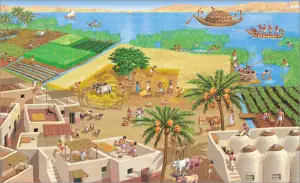“Hail to thee, O Nile! Who manifests thyself over this land, and comes to give life to Egypt! For a Civilisation to flourish, the presence of a river is inevitable. The Ancient Egypt Nile River has been the lifeline of Egyptian civilization time and again. There is no better way to trace the course of Egyptian history than to follow the course of the Nile, the longest river on earth (6,695 kilometers).

The Nile has helped ancient Egyptians in various ways. The river had the ability to produce extremely fertile soil. The Egyptians called their country Kemet, meaning “the Black Land,” a reference to the dark, fertile soil that remained after the Nile floodwaters had receded. This was immensely advantageous to a land which consisted of dry desert land and had scanty rainfall throughout the year.
Importance of Ancient Egypt Nile River
It provided a source of drinking water, irrigation for farming etc. It was also the source of fish and helped to establish a fishing industry later on. Bricks were made from the mud from the river’s banks where as the mud was used as a raw material for a well-established pottery industry. Quarrying, Mining, and Processing of stones, gems, metals, and salts took place. Boats were built and used for navigation.
Ancient Egypt Nile River also protected the Egyptians from external attacks. The enemies would have to first cross the river, which was a very difficult and complex task. The river also helped to promote trade. The Nile was the quickest and easiest way to travel from place to place.
The Nile floods the lands in Egypt, leaving behind black sediment. That’s why the ancient Egyptians named the river Ar, meaning black. The Nile flooded annually, between June and September. The Egyptians planned ahead after noticing the occurrence of floods in the same time every year. The course of the river changed over time. The land became available as the riverbed shifted, and new houses were built along the riverfront, while the old ones decaying.
To the Egyptians, the reasons for the flooding and the origins of the Nile remained mysterious, but they were aware of their dependence to the river. They deified it as Hapi giving him the form of a well-nourished bearded blue man. Hapi was the Nile God. Honouring a god was very important, so when a flood came the Egyptians would thank Hapi for bringing fertility to the land.
The Nile Crocodile has been a major component of the Egyptian culture and way of life since the first Egyptians settled along the fertile banks of the Nile. Most Nile Crocodiles are approximately 4 meters in length, although some have been reported as longer. The animals make their nests along the banks of the Nile River, where the female may lay up to 60 eggs at one time.
Some three months later the babies are born and are taken to the water by their mother. They will remain with her for at least two years before reaching maturity. The catchment area of the Nile is huge, more than 3 million square kilometers with a mean annual rainfall of about 600 mm at present. A large part of the water the Nile carries originates in Ethiopia and is due to the summer monsoons. The rest comes from as far south as Rwanda.
